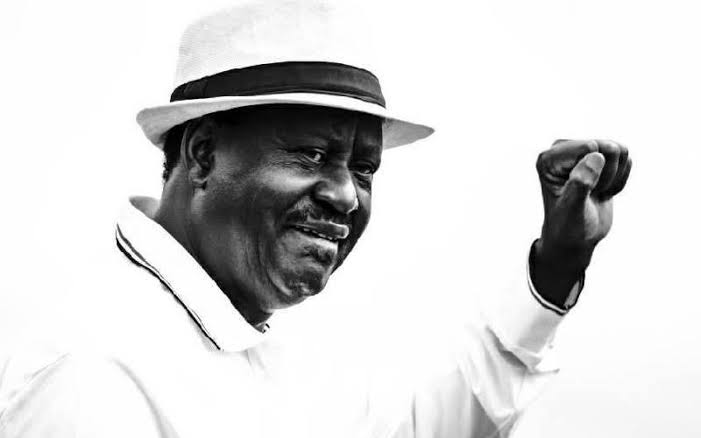
Ruto honours Raila with Kenya’s highest award
Ruto awards Raila Chief of the Golden Heart of Kenya (CGH)
The award symbolises selfless service, national unity and excellence in leadership.
In Summary

Audio By Vocalize

President William Ruto on Monday posthumously conferred Kenya’s highest civilian honour, the Chief of the Order of the Golden Heart (C.G.H.), on the late former Primary Minister Raila Odinga.
On behalf of a grateful nation, and through the authority vested in me as President, I have today posthumously conferred upon the Right Honourable Raila Amollo Odinga the highest honour of the Republic,” Ruto said in his national address.
The honor was done during the Mashujaa Day celebrations at Ithookwe Stadium in Kitui County.
The award recognises Raila’s decades-long contribution to Kenya’s democratic development, public service and national leadership.
This historic gesture has sparked renewed interest in the meaning, history and significance of the award.
What is the Chief of the Order of the Golden Heart
The Chief of the Order of the Golden Heart is the highest class within the country’s national honours system.
It is part of the Order of the Golden Heart of Kenya, which includes three levels being the Chief (C.G.H.), Elder (E.G.H.) and Moran (M.G.H.).
Established under the National Honours Act of 2013, the award is conferred by the President to individuals who have demonstrated exceptional service, patriotism, leadership or heroism.
Who qualifies for the Award
Recipients of the C.G.H. are individuals who have demonstrated exceptional service, integrity, and leadership in advancing Kenya’s welfare or global reputation.
The President awards the honour on the recommendation of the National Honours and Awards Committee, which operates under the Office of the President.
The committee evaluates candidates based on contributions to governance, peace, humanitarian causes, innovation, or socio-economic development.
According to the National Honours Act, state awards may be granted to Kenyans or foreign nationals who have “rendered outstanding or distinguished service to the nation.”
It is conferred through a Gazette Notice, which formalises the honor and outlines the reasons for the award.
Symbolism and design
The medal features a golden five-pointed star surrounded by a wreath and suspended from a ribbon in Kenya’s national colours.
It symbolises selfless service, national unity and excellence in leadership.
It is accompanied by an official citation and a place in the national roll of honour, signifying the recipient’s enduring legacy.
History and past recipients
The award dates back to 1966, when Kenya’s first President Jomo Kenyatta established it to honour individuals who had made extraordinary contributions to the young Republic.
Notable past recipients include Mzee Jomo Kenyatta and other former presidents including Daniel arap Moi, Mwai Kibaki and Uhuru Kenyatta.
Former UN Secretary General Ban-Ki Moon and Prince Rahim Aga Khan V were also awarded the C.G.H.
Raila’s inclusion marks a rare instance of a non-head-of-state receiving the award, and the first time it has been conferred to an opposition leader.
What does the Award symbolise
The Chief of the Order of the Golden Heart symbolises national gratitude, heroism and sacrifice, and leadership and unity.
Recipients wear a golden breast star and ribbon during official state functions.
The award is not just ceremonial, it reflects the Republic’s highest esteem and serves as a permanent record of the recipient’s legacy.
Why Was Raila Odinga honored
Raila, who passed away on Wednesday, October 13, 2025, and was buried in Bondo on Sunday, was recognised for his role as a principal architect of Kenya’s modern democratic order.
Raila’s legacy includes championing multiparty democracy in the 1990s, serving as Prime Minister from 2008 to 2013.
Others are leading major constitutional reforms, including the 2010 Constitution, and advocating for electoral justice and national unity, among others.
His recognition during Mashujaa Day, a holiday dedicated to honoring heroes, was widely seen as a gesture of national reconciliation and unity.
Why it matters now
The 2025 conferment carries deep national significance.
It acknowledges Raila’s role in shaping Kenya’s political landscape and promotes healing and unity following his passing.
It also sets a precedent for recognising non-presidential figures whose impact transcends politics.
The move bridges the country’s often divisive political history, reaffirming the state’s commitment to celebrate contributions beyond partisanship.
By elevating Rail to the highest rank of honour, the government underscores that heroism transcends politics; it is defined by service to country, courage in adversity, and unwavering belief in Kenya’s promise.
By honoring Raila during Mashujaa Day, the government reaffirmed the day’s purpose to celebrate those who have sacrificed for the country’s freedom, democracy, and progress.

Ruto awards Raila Chief of the Golden Heart of Kenya (CGH)